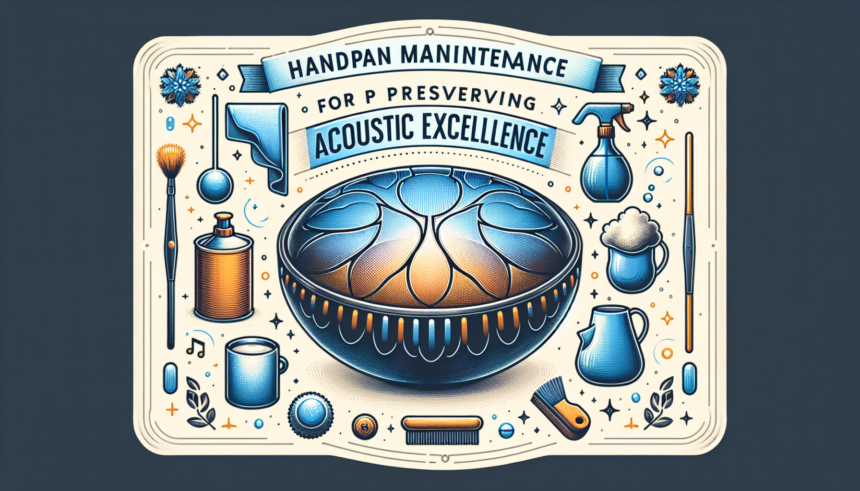<!DOCTYPE html>
<html lang="en">
<head>
<meta charset="UTF-8">
<meta name="viewport" content="width=device-width, initial-scale=1.0">
<title>Handpan Maintenance Tips for Preserving Acoustic Excellence</title>
<style>
body {
font-family: Arial, sans-serif;
line-height: 1.6;
padding: 20px;
}
h1, h2, h3 {
color: #333;
}
ul {
padding-left: 20px;
}
.faq-section {
margin-top: 30px;
border-top: 1px solid #ccc;
padding-top: 20px;
}
</style>
</head>
<body>
<article>
<h1>Handpan Maintenance Tips for Preserving Acoustic Excellence</h1>
<p>The handpan, a unique and ethereal musical instrument, requires diligent care to maintain its extraordinary sound quality. Whether you're a beginner or a seasoned player, understanding the nuances of handpan maintenance is critical for preserving acoustic excellence and ensuring longevity. This article provides detailed insights and tips on how to care for your handpan, drawing upon techniques and considerations that address the unique needs of this instrument.</p>
<h2>Understanding the Handpan's Sensitivity</h2>
<p>Handpans are crafted with precision and are highly sensitive to physical and environmental changes. The instrument’s body is primarily made of nitrided or stainless steel, materials chosen for their durability and tonal properties. However, the handpan's sensitivity necessitates care in handling and storage to prevent damage to its tuning and surface integrity.</p>
<h2>Handling Your Handpan</h2>
<p>When handling your handpan, it's important to adopt a gentle and mindful approach. Avoid dropping or bumping the instrument against hard surfaces. When not in use, store your handpan in a padded bag or hard case to protect it from accidental damage and environmental elements. Many handpan players invest in gig bags specifically designed with ample padding and weather-resistant materials.</p>
<h2>Cleaning and Surface Care</h2>
<p>Cleaning your handpan is an essential routine to maintain its surface and sound quality. Here are some steps to follow:</p>
<ul>
<li><strong>Regular Dusting:</strong> Use a soft, lint-free cloth to dust off the surface of your handpan regularly. This prevents the buildup of dust and dirt that can affect the instrument's sound.</li>
<li><strong>Oiling:</strong> Applying a thin layer of oil, such as mineral oil or a specific handpan oil, helps prevent rust and oxidation. Rub the oil onto the surface with a soft cloth, ensuring it covers the entire body evenly.</li>
<li><strong>Avoid Water:</strong> Keep the handpan dry and away from moisture, as water can lead to rust. If the instrument gets wet, dry it thoroughly and immediately apply oil to protect the surface.</li>
<li><strong>Avoid Abrasive Cleaners:</strong> Never use harsh chemical cleaners or abrasives. These substances can damage the handpan’s surface and alter its finish and sound.</li>
</ul>
<h2>Environmental Considerations</h2>
<p>Given its sensitivity, the handpan is best preserved in stable environmental conditions. Avoid exposing your handpan to extreme temperatures, humidity, or direct sunlight. These elements can cause the metal to expand or contract, potentially detuning the instrument or causing structural damage.</p>
<h3>Humidity and Temperature</h3>
<p>Maintaining a consistent level of humidity and temperature is crucial. A room with controlled humidity levels, ideally around 40-50%, can prevent rust and deformation. If you reside in a particularly humid area, consider using a dehumidifier. Conversely, in dry climates, a humidifier can help maintain optimal conditions for your handpan.</p>
<h3>Long-term Storage</h3>
<p>For long-term storage, it's advisable to keep the handpan in its case, while ensuring that silica gel packets or dehumidifiers are placed with it to combat moisture. Never place your handpan near heating vents or in places where it could be subject to rapid temperature changes.</p>
<h2>Ensuring Tuning Stability</h2>
<p>The handpan’s mesmerizing sound is attributed to its meticulous tuning. Unfortunately, rough handling, frequent travel, and environmental factors can cause detuning. To ensure tuning stability:</p>
<ul>
<li><strong>Handle With Care:</strong> Always transport your handpan in a protective case, and refrain from placing heavy objects on top of it.</li>
<li><strong>Regularly Check Tuning:</strong> Play the notes around the handpan and listen for any discrepancies or distorted sounds. Regular tuning checks are vital for maintaining its sound quality.</li>
<li><strong>Professional Tuning:</strong> If you notice significant detuning, consult with a professional tuner who specializes in handpans to restore its original acoustics.</li>
</ul>
<h2>Resilience against Corrosion</h2>
<p>Nitrided and stainless steel handpans are designed to resist rust, but they are not entirely immune to it. To enhance resilience:</p>
<ul>
<li><strong>Apply Protective Oils:</strong> As mentioned, using oil regularly helps in creating a protective barrier against moisture and oxidation.</li>
<li><strong>Avoid Prolonged Exposure:</strong> Prevent your handpan from being exposed to salty air or environments where humidity is high.</li>
<li><strong>Clean After Playing:</strong> Wipe your handpan after each use to remove sweat or oils from your hands, which can accelerate corrosion.</li>
</ul>
<h2>Travel and Transportation Tips</h2>
<p>Musicians who travel often with their handpans should take extra precautions during transportation:</p>
<ul>
<li><strong>Soft Cases vs. Hard Cases:</strong> A hard case is ideal for flight and long journeys, while a padded soft case can be sufficient for short trips or casual commuting.</li>
<li><strong>Air Travel Considerations:</strong> Bring your handpan as carry-on luggage if possible. Inform security personnel about your instrument during the screening process to ensure it is handled with care.</li>
<li><strong>Vehicle Storage:</strong> Never leave your handpan in an unattended car, especially in extreme temperatures. If necessary, place it in a protected location within the vehicle.</li>
</ul>
<h2>Conclusion</h2>
<p>Maintaining a handpan requires dedication and understanding of its delicate nature. By following proper handling techniques, environmental management, and regular cleaning practices, your handpan can retain its acoustic brilliance and visual appeal for years to come. The investment in care not only preserves the instrument’s beauty but also enhances the joy and musicality it offers to both players and listeners.</p>
<div class="faq-section">
<h2>Frequently Asked Questions</h2>
<h3>1. How often should I oil my handpan?</h3>
<p>Ideally, you should oil your handpan every month, but the frequency can depend on your local climate and usage. Regular oiling prevents rust and keeps your handpan in excellent condition.</p>
<h3>2. Can I use any type of oil on my handpan?</h3>
<p>No, it’s best to use mineral oil or oils specifically designed for handpans. Avoid food-based oils as they can spoil and attract pests.</p>
<h3>3. What should I do if my handpan gets scratched?</h3>
<p>Minor scratches can often be managed by oiling to protect against rust. For significant scratches, consult a professional for repairs and further guidance.</p>
<h3>4. Is it necessary to get professional tuning for minor detuning?</h3>
<p>While minor detuning might not be noticeable to all players, professional tuning is recommended to ensure optimal sound quality and maintain the instrument’s integrity.</p>
<h3>5. How can I prevent my handpan from detuning during travels?</h3>
<p>Always use a heavily padded gig bag or hard case during travels, avoid placing any weight on top of the handpan, and handle it with care throughout your journey. Regularly check tuning after reaching your destination.</p>
</div>
</article>
</body>
</html>Handpan Maintenance Tips for Preserving Acoustic Excellence

Leave a comment




